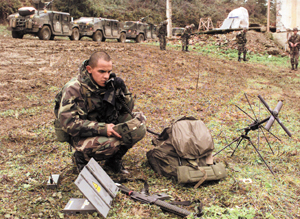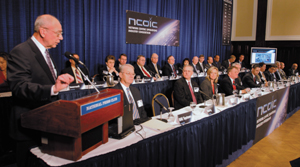A clear signal

When Dawn Meyerriecks, then chief technology officer of the Defense Information Systems Agency, was briefing industry executives last summer on DISA's Network-Centric Enterprise Services initiative, she warned them that the Defense Department didn't want contractors to offer competing standards when proposing solutions.
When Dawn Meyerriecks, then chief technology officer of the Defense Information Systems Agency, was briefing industry executives last summer on DISA's Network-Centric Enterprise Services initiative, she warned them that the Defense Department didn't want contractors to offer competing standards when proposing solutions."We want people to compete in terms of military-unique capabilities," Meyerriecks said. "We don't want people to compete on how to move a message from one process to another."Adm. Edmund Giambastiani, head of the Joint Forces Command, echoed those sentiments at an IT symposium last month in Virginia, offering little sympathy to integrators that want to pursue their own technology platforms."We are aggressively including industry in military force transformation, but in a nonproprietary way," Giambastiani said. "Some companies don't like that. But if you're not delivering coherently integrated, interoperable capabilities today, then you are creating the joint problems of tomorrow."The message to contractors is clear: If the Defense Department is to realize the full benefits of network-centric operations, then integrators that build the military's sophisticated communications and weapons systems must become collaborators -- at least when it comes to basic interoperability.Industry read the writing on the wall, and Sept. 28, after almost a year of negotiating among themselves, 28 companies pledged to work together and agree on standards that would let military systems seamlessly communicate. At issue are challenges such as how data will move from platforms such as the Warfighter Information Network-Tactical, led by General Dynamics Corp., to Future Combat Systems, led by Boeing Co."There are hundreds of communication infrastructures in place, and rarely can they interoperate," said Carl O'Berry, Boeing's vice president of strategic architecture and executive chairman of the new Network Centric Operations Industry Consortium.It's not easy to corral companies that are often on opposite sides of a bid and that have invested substantial resources in proprietary architectures. As one consortium executive put it, the gathering is not a "love fest."Before the consortium could get started, minds had to be put at ease. Lockheed Martin Corp. initially resisted, concerned that others might promote their system architectures through the consortium."There were a couple things that were very important to us that had to be there for us to feel comfortable to play," said Lorraine Martin, vice president for joint command, control and communications systems at Lockheed Martin. "When you bring these kinds of industry players together, you need to make sure that nobody is bringing something to the table that might give them an advantage," Martin said. "You can't bring things to the table that would be considered proprietary, or intellectual property from a company that's not going to be shared." Lockheed Martin also wanted to be sure that any standards the consortium adopted and information it produced would be made public, she said.Trey Smith, executive vice president of federal business at Science Applications International Corp., credits Boeing's O'Berry for creating an atmosphere where the customer's needs come first. O'Berry, who spent 38 years in the Air Force and as deputy chief of staff for command, control, communications and computers, spearheaded formation of the consortium, pitching his ideas to executives at a series of meetings in September 2003."The relationships, the experience, the background he has, have been major factors in getting these companies aligned," Smith said. Experts said the consortium is a move in the right direction. "The more people you have in the same tent, the more likely you are to succeed," said James Lewis, director of technology and public policy at the Center for Strategic and International Studies in Washington.But success will depend on the commitment of the members. "Sometimes companies join these things to see what the other guy is up to," Lewis said. "If this works, it can speed up net-centric deployment. If not, you'll still see net-centric moving ahead."Membership in the non-profit consortium is based on a tiered system that reflects the amount of money a company contributes, with members of the top tier controlling operations. But each company has one vote on the executive council regardless of tier, said spokeswoman Janet Kopec. She declined to identify the companies in the most influential tier.About 20 more companies have expressed interest in joining, Kopec said. The consortium expects to gather at the end of November and come up with a set of milestones.Although a gradual process of reaching consensus may seem at odds with the Defense Department's desire to spiral systems into the field as quickly as possible -- the Army moved up WIN-T by a year to develop an architecture by early 2005 -- consortium executives said the industry group would have a long-term impact."This is the only way to get the spiral really working," O'Berry said.O'Berry said there is nothing in the consortium's charter that would prevent a member from fielding a proprietary system if the customer demanded it. But he also said Boeing would be willing to rip out application layers in new and existing systems if replacing them with standard components enhanced interoperability.SAIC's Smith agreed it will be important for the consortium to stick to those areas of networked systems where standards make the most sense: in the network, transport and session layers."But if you climb up into 'How am I going to do the presentation of Blue Force Tracking?' you're inherently going to have a lot of competing standards and technologies, and it's going to be a tough, tough problem to sort through," Smith said.Robert Dees, executive director for defense strategies for Microsoft Corp.'s federal business, said the consortium can implement standards and meet the Defense Department's timelines. The software giant worked with Lockheed Martin, Northrop Grumman Corp. and others on the Air Force's Synchronized Air Power Management program, which uses XML Web services and other standards to exchange data between legacy systems."Command support, contractor teaming and innovative technology were critical to making headway," Dees said. "We went from stovepipes to interoperability in 12 weeks."With interoperability standards ironed out, there will likely be more and better competition for network-centric operations contracts, Martin said.Brad Grimes can be reached at bgrimes@postnewsweektech.com.XXXSPLITXXX-



The message to contractors is clear: If the Defense Department is to realize the full benefits of network-centric operations, then integrators that build the military's sophisticated communications and weapons systems must become collaborators ? at least when it comes to basic interoperability.
DOD

- BAE Systems North America Inc., Rockville, Md.
- Boeing Co., Chicago
- CACI International Inc., Arlington, Va.
- Carrillo Business Technologies Inc., Westminster, Calif.
- Cisco Systems Inc., San Jose, Calif.
- European Aeronautical Defence and Space Co., Amsterdam
- EMC Corp., Hopkinton, Mass.
- Ericsson, Stockholm
- Factiva, New York
- Finmeccanica, Rome
- General Dynamics Corp., Falls Church, Va.
- Hewlett-Packard Co., Palo Alto, Calif.
- Honeywell International Inc., Morristown, N.J.
- IBM Corp., Armonk, N.Y.
- Innerwall Inc., Colorado Springs, Colo.
- L-3 Communications Corp., New York
- Lockheed Martin Corp., Bethesda, Md.
- Microsoft Corp., Redmond, Wash.
- Northrop Grumman Corp., Los Angeles
- Oracle Corp., Redwood Shores, Calif.
- Raytheon Co., Waltham, Mass.
- Rockwell Collins Inc., Cedar Rapids, Iowa
- Saab AB, Stockholm
- Science Applications International Corp., San Diego
- Smiths Aerospace, London
- Sun Microsystems Inc., Santa Clara, Calif.
- Thales Group, Neuilly-sur-Seine, France
- Themis Computer Inc., Fremont, Calif.
NEXT STORY: Outsourcing runs aground in Florida

